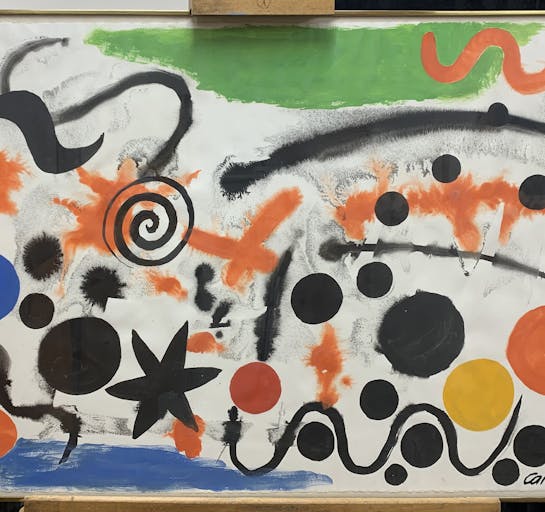Alexander Calder
1898-1976

Alexander Calder
1898-1976
One of America's best known sculptors, "Sandy" Calder became most famous for his kinetic abstract mobiles. He also did floor pieces, was a painter in watercolor, oil and gouache, did etchings and serigraphs, and made jewelry and tapestries as well designed theater stage settings and architectural interiors.
He was born in Philadelphia, the son of Alexander Sterling Calder and the grandson of Alexander Milne Calder, well-known sculptors of public monumental works. His mother, Nanette Lederer Calder, was a professional portrait painter. As a result of his father's ill health the family went West in search of drier warmer weather. When Sandy was a teenager, the family returned to Pennsylvania.
He was unable to make a decision about a vocation, but his fascination with machines led to his earning a degree in mechanical engineering. He tried a variety of jobs, however ended up enrolling in the Art Students League in New York City in 1923. His teachers were John Sloan, Guy Pene Du Bois, and Boardman Robinson.
In 1926, he went to Paris where he lived the next seven years and shortly after his arrival began doing wire sculpture. He also met many of the leading avant-garde artists of the day including Piet Mondrian. His floor pieces, named "stabiles" by Jean Arp, were exhibited in a gallery exhibition organized by Marcel Duchamp, who coined the word "mobile" for the hanging, kinetic pieces.
Calder's mobiles were first shown in the United States in 1932, and the next year he returned to America and purchased a home in Roxbury, Connecticut where he lived the remainder of his life.
Many federal agencies and businesses commissioned works by him, and most major American museums have his pieces in their collections.
His death in 1976 occurred coincidentally with a major retrospective of his work at the Whitney Museum of American Art in New York. His last words, "I'll do it myself", tell the story of his life.
Source: Askart.com
